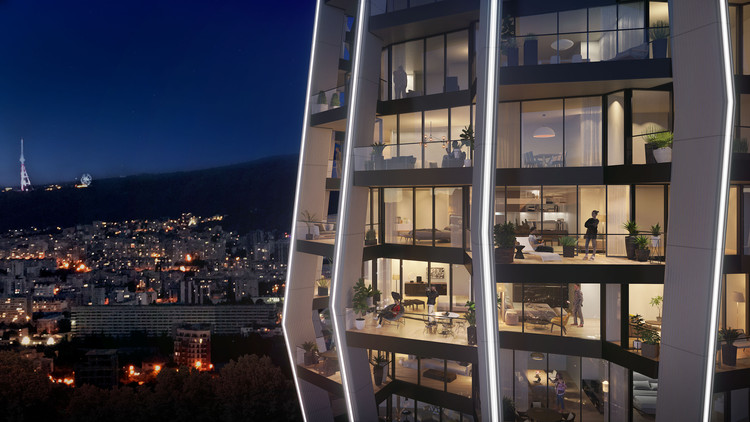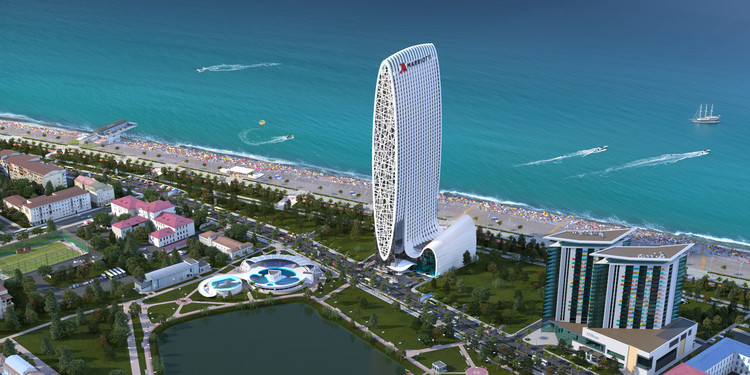
Architects and developers have always been on opposite ends of the construction world. While the first wanted to create dreamy spaces, the latter just wanted to cater to the basic needs. In these past few years, the world has witnessed significant changes, with the aggravation of climate-related issues, the evolution of technological solutions, and the newly acquired awareness and growth of the population.
While everything is transforming, building trends also evolved, mainly due to an alteration in people’s perceptions and priorities. However, one question remains unanswered: Could all these changes mean that the never-ending conflict between architects and developers reached some sort of common grounds? And could they finally be seeking one same goal, of a sustainable, resilient and inclusive future?
ArchDaily had the opportunity to discuss sustainability, resilience, and cities with Chris Lepine, Associate Director at Zaha Hadid Architects and two major developers in Georgia, Nodar Adeishvili, Director General of LISI Development, and Temur Bitsadze, Chief Development Officer of Alliance Group. The conversation occurred during a forum in Tbilisi, entitled Building Sustainable and Resilient Cities, organized by Property Georgia and FIABCI Georgia. Read on to discover a newly developed understanding between the different parties, highlighted through their most prominent projects.

ArchDaily (Christele Harrouk): How would you describe your general approach?
ZHA: At Zaha Hadid Architects, we are always trying to push forward the design, give back to the city, and generate a unique experience for the inhabitants and for the community. With our latest completed project, 1000 museum, a very prominent structure on the Miami skyline, we had to think about something special, for it was the last gap in a row of towers. For example, the tower hits the ground, with a cut on its corner to create more breathing space and have a presence on the pedestrian level. Through our international work, we get to see that we live in a global society, and clients nowadays have a lot of knowledge about innovative products and building techniques. We always try to work with novel methods, that we can potentially bring to other projects and gain from our experience.

Lisi: Green Town in Tbilisi is built on only 20% of the land, with 80% accessible open and green spaces. Although we are not central, but we are situated on a hill overlooking the city, we are selling at the same rate apartments in the city center would go for. In fact, we have created a neighborhood, with all the amenities possible, so that no one goes out of the district, or takes his car. In this development, we have worked with Georgians architects as well as international collaborators like UN studio, and Ricardo Bofill. We wanted to bring big names to make iconic buildings in the district and for marketing and development purposes. On another hand, regarding other projects, we are always following the same concept, by ensuring maximum free land for the public, and that is how we are developing ski resorts in Bakuriani, a mixed-use with energy-efficient houses.

Alliance: People worldwide are not happy with high-rises. Nevertheless, we have a different concept, that drives our architectural decisions because we are more focused on developing mixed-use projects, and on gathering multiple functions in one plot. We might build high rises in the city center, but we do so with environmentally friendly decisions and approaches, and excellent architectural design. For example, we include a lot of green spaces in our interventions, and we make the best of our rooftops by installing wind turbines, to generate electricity in common areas. Façades of the buildings direct the rain towards water collectors, to irrigate the open spaces, and natural sunlight is abundant in our interiors.

AD: How would you define sustainability?
ZHA: Sustainability requires multiple layers of involvement from the architects, the developers, and the city. 1000 museum is built according to the Florida green building condition and is certified platinum, in concordance with the client’s brief and wishes. A lot of it comes down to how the mechanical equipments are specified, how efficient they are, the MEP standards, high-performance glass, recessed balconies for shading, interior gardens, etc. Basically, sustainability is, design and technology at the same time, but I think technology will have a bigger part to play in the future with more efficient innovations.

Lisi: Sustainability and profitability are a challenge, and this is where we found an opportunity to make a difference. Actually, the site of our project was not perceived as livable 5 years ago. Today it is a very prestigious district, mainly because we didn’t just put standards but we introduced a new lifestyle, especially for families. Most of our clients already had apartments in the center but were seeking an ecologically friendly area, green zones, public spaces, and other basic needs that became unattainable in cities.

Alliance: Basically, in hotels and residential, technological tools are helping us deliver environmentally friendly outcomes. Sustainability has also an important financial aspect to it, it is also about creating steady incomes, from our ventures. In fact, our clients will keep investing with us as long as we are assuring a return on their investments.

AD: What does Resilience mean to you? and how is it portrayed in your work?
ZHA: Resilience means a building that bounces back, with a certain strength. For sustainability, there are a bunch of techniques, technologies, a lot of checklists to say if it’s sustainable or not, but when it comes to resilience, it’s a completely different approach. What makes a city strong and resilient is actually the people that want to be in that space, and that are attracted to that area. A resilient urban entity is a place that people take pride in. If this doesn’t exist, then the city will never be resilient nor sustainable. If you actually create a place that no one wants to be in, even if it follows all the sustainable checklists, it will not survive. It has to be a place where people want to be.

Lisi: We are a role-model for the city, showcasing how the private sector can make a change. Resilience is to say that we don’t want to build on 80% of the land, we want to build on 20% of the land we are developing. This is how we make a change, in the culture and approach of the business, and contribute to the city by devoting more green spaces, while being a profitable company.

Alliance: We are creating landmarks that stand out and make the city different. Our goal is to differentiate our city from others, and our structures are conceived to cater to this urban entity. We create beautiful structures because the city needs innovations and needs attractive constructions. Whatever we are creating, we are not only thinking on the investment level but on a bigger futuristic scale.

AD: How are you introducing these relatively new ideas to clients?
ZHA: Just like any other architect, faced with a site and a certain allowable GFA (Gross floor area), we confront clients that want to maximize the exploitable areas. Our approach is based on proposing ways where a developer can get just as much through good design, and clever solutions rather than maximizing the GFA. That is not always convincing for the other party, that’s why I think that we need better governmental regulations and incentives to back up our ideas. Aesthetically we have our signature, and we always try to provide a space that people can enjoy so that our intervention becomes part of that urban condition rather than a completely isolated work of architecture. In our project in Bratislava, where we have several residential towers on a garden site, the park is accessible to the general public. In fact, the private developer used our proposal, to his advantage, while negotiating the permissions with the city council.

Lisi: 6 years ago, persuading clients was a big challenge, and the problem was actually explaining what this place will look like, several years later. In fact, it’s all about timing, the right product at the right place. For us, it was about being innovative and the first to deliver ecologically friendly areas with green zones near the city center. Along with the project, and within our territory, we have developed 2 schools, in order to create an educational hub. The main idea was to eliminate the need to move outside of the district, so we created everything within a walkable distance, like small stores, pharmacies, and kindergartens. It’s a learning curve, and we are always adding some benefits to the district. For example, we started harvesting rainwater and added electrical chargers on the streets to incentivize people to buy electric cars.

Alliance: Architects often want to imagine something exceptional, that doesn’t fit in the agenda of the developers. In our projects, we try to push for what the architect desires, because we believe that he is portraying the needs of the future tenants. We also try to compensate for building huge constructions in front of modest buildings, by implementing playful designs that are keen on preserving the original panoramas. In all our projects, we create an important infrastructure of common spaces and we generate semi-public spaces on the ground floors. Our green spaces on the inside and outside are always accessible by the public. Environmentally friendly approaches are considered to be the major reason why some clients seek to invest in our projects.





























